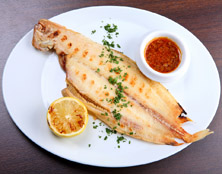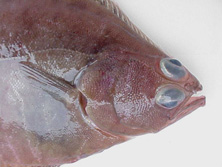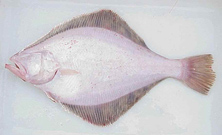Flathead Sole (Hippoglossoides elassodon)
- Flathead sole population levels are very healthy.
- In Alaska, the flathead sole fishery is managed by the North Pacific Fishery Management Council through a series of measures including annual catch quotas.
- Flathead sole is an excellent source of low-fat protein, calcium, and other important nutrients. For more on nutrition, see Nutrition Facts. (USDA)
- The United States catches the majority of the world's harvest of flathead sole.
|
 |
 |
 |
 |
| Nutrition Facts |
| Servings 1 |
| Serving Weight
100g |
 |
| Amount Per Serving |
 |
| Calories 91 |
 |
| Total Fat |
1.19 g |
 |
| Total Saturated Fatty Acids |
0.283 g |
 |
| Carbohydrate |
0 g |
| Sugars |
0 g |
| Total Dietary
Fiber |
0 g |
 |
| Cholesterol |
48 mg |
 |
| Selenium |
32.7 mcg |
 |
| Sodium |
81 mg |
 |
| Protein |
18.84 g |
 |
|
 |
 Sole sampled during the Alaska Fisheries Science Center's 2005 Gulf of Alaska Bottom Trawl Survey, which assesses the status of groundfish in the Gulf of Alaska. Sole sampled during the Alaska Fisheries Science Center's 2005 Gulf of Alaska Bottom Trawl Survey, which assesses the status of groundfish in the Gulf of Alaska.
|
 |
Did you know?
Flathead sole is very similar to the Bering flounder (Hippoglossoides robustus).
Flathead sole were of limited commercial use in the past but are now becoming more important.
Flathead sole do not seem to feed much during their spawning season.
|
|
| |
 |
|
Flathead sole are a right-eyed flatfish. The left eye migrates over to the right side during development. Flathead sole have pores under their eyes.
|
 |
|
The eyed-side of flatfish are typically pigmented (flathead sole are dark olive brown to reddish gray-brown, sometimes with dusky blotches); the blind side is white, as shown above.
|
|
Sustainability Status
Biomass: Gulf of Alaska and Bering Sea/Aleutian Islands area biomass estimates are very high, at 241% and 177%, respectively, above the biomass needed to support maximum sustainable yield.
Overfishing: No (Alaska); Unknown (West Coast)
Overfished: No (Alaska); Unknown (West Coast)
Fishing and habitat: In Alaska, flathead sole are primarily caught by bottom trawl gear over sand and mud habitats, which are not as likely to be damaged by trawling as other habitats.
Bycatch: In the Bering Sea/Aleutian Islands, the principal bycatch species in the flathead sole fishery are pollock, Pacific cod, and arrowtooth flounder. In the Gulf of Alaska, the principal bycatch species are arrowtooth flounder and rex sole.
Aquaculture: There is currently no commercial aquaculture of flathead sole in the United States.
|
Science and Management
The North Pacific Fishery Management Council manages the flathead sole fisheries in the Exclusive Economic Zone (EEZ) off Alaska. In the Bering Sea and Aleutian Islands (BSAI) area, the flathead sole fishery is regulated under the BSAI Groundfish Fishery Management Plan (FMP). The FMP controls the fishery through permits and limited entry, catch quotas, seasons, in-season adjustments, gear restrictions, closed waters, bycatch limits and rates, allocations, regulatory areas, record keeping and reporting requirements, and observer monitoring. Flathead sole was managed as part of the "other flatfish" complex until 1995.
The flathead sole fishery in the Gulf of Alaska (GOA) is regulated under the GOA Groundfish FMP. The FMP controls the fishery through similar measures as the BSAI Groundfish FMP. Flathead sole is assigned a separate allowable biological catch (an estimate used to set catch quotas) from the deep water flatfish complex since it overlaps the depth distributions of the both shallow and deep water groups. In 1998, trawling was prohibited in the Eastern Management Area east of 140º W longitude (now the Southeast Management Area).
On the West Coast, flathead sole is included in the Pacific Fishery Management Council's Pacific Coast Groundfish Fishery Management Plan as part of the "Other Flatfish Complex". These species are not assessed.
NOAA's Alaska Fisheries Science Center conducts bottom trawl surveys annually on the shelf in the Eastern Bering Sea and on a biennial basis in the Gulf of Alaska to provide an index of population abundance. Full age-structured stock assessments are conducted annually for the BSAI stock and bi-annually for the GOA stock to help set fishery targets and limits for flathead sole catches.
|
Life History and Habitat
Life history, including information on the habitat, growth, feeding, and reproduction of a species, is important because it affects how a fishery is managed.
- Geographic range: Flathead sole are found on the Pacific Coast of North America from Monterey Bay, central California northward through the Gulf of Alaska and across the Bering Sea .
- Habitat: Flathead sole nursery areas are in shallow (less than 330 feet) estuaries, bays and nearshore coastal areas along the northern Pacific coast. Larvae and eggs float near or on the surface. After they metamorphose, they settle to the bottom. Adult flathead sole spend the winter near the shelf margins then move to the mid and outer continental shelf in spring to feed. They live on mixed mud and sand bottoms in depths less than 980 feet.
- Life span: Males live at least 30 years, and females live at least 27 years.
- Food: Flathead sole prey on invertebrates found on the ocean floor such as crustaceans, mollusks, and brittle stars, as well as fish and squid. Their diet varies with area and season.
- Growth rate: In both the BSAI and GOA, males grow faster than females, while both sexes grow somewhat faster in the GOA as compared to the BSAI.
- Maximum size: Adults can grow to 1.8 feet. Females generally reach larger sizes than males.
- Reaches reproductive maturity: Males and females may mature as young as 2 to 3 years in Puget Sound, but not until 6 years in the Bering Sea.
- Reproduction: Depending on their size, females can have 72,000 to 600,000 eggs. Eggs are large and are fertilized externally. They hatch in 9 to 20 days, depending on water temperature.
- Spawning season: February through April.
- Spawning grounds: In deeper waters near the margins of the continental shelf.
- Migrations: Flathead sole migrate from winter spawning grounds along the outer shelf to shallower water feeding grounds in the spring.
- Predators: In the Bering Sea/Aleutian Islands area, the main predators of adult flathead sole are Pacific cod and Alaska pollock. Pacific cod and skates prey on flathead sole less than 2 inches in length. Other predators include arrowtooth flounder, Greenland turbot, and Pacific halibut. In the Gulf of Alaska, Pacific cod and Pacific halibut are the major predators of adults, while arrowtooth flounder, sculpins, Alaska pollock, and Pacific cod are the major predators on juveniles.
- Commercial or recreational interest: Both
- Distinguishing characteristics: Flathead sole are a right-eyed flatfish with an oval-shaped or rather elongate, compressed body. Their eyed side is dark olive brown to reddish gray-brown, sometimes with dusky blotches. Their blind side has white and translucent areas, and their dorsal and anal fins have dusky blotches. Flathead sole have pores under their eyes. The upper jaw is narrow in the middle and has 1 row of teeth.
|
Role in the Ecosystem
Flathead sole occupy intermediate trophic levels in both the eastern Bering Sea and Gulf of Alaska ecosystems.
|
Additional Information
Market names: Sole or Flounder
Vernacular names: Flathead Flounder, Halibut-like Flounder
|
Biomass
 Biomass refers to the amount of flathead sole in the ocean. Scientists cannot collect and weigh every single fish to determine biomass, so they use mathematical models to estimate it instead. These biomass estimates can help determine if a stock is being fished too heavily or if it may be able to tolerate more fishing pressure. Managers can then make appropriate changes in the regulations of the fishery.
Biomass refers to the amount of flathead sole in the ocean. Scientists cannot collect and weigh every single fish to determine biomass, so they use mathematical models to estimate it instead. These biomass estimates can help determine if a stock is being fished too heavily or if it may be able to tolerate more fishing pressure. Managers can then make appropriate changes in the regulations of the fishery.
In the Bering Sea and Aleutian Islands area, estimated biomass approximately quadrupled since the early 1980s and peaked in 1997 at almost 800,000 tons. Estimated biomass then declined to about 390,000 tons in 2000 before increasing to over 620,000 tons in 2006. Subsequently, survey estimates decreased to 535,356 tons in 2008.
In the Gulf of Alaska, survey estimates of total biomass have fluctuated about a mean of about 220,000 tons, with no apparent trend, since 1984. Estimated total biomass was about 280,000 tons in 2007, the largest in the time series, and a 33% increase over the 2005 estimate of around 210,000 tons.
Flathead sole is not assessed off the West Coast.
Landings
 Landings refer to the amount of catch that is brought to land. In the Bering Sea and Aleutian Islands area, catches of flathead sole averaged about 5,300 tons from 1977 to 1989. Since 1990, annual catches have averaged over 17,000 tons. Prior to 2008, substantial amounts of flathead sole have been discarded overboard in various Eastern Bering Sea target fisheries (including the fishery for flathead sole); 24% of the 2006 flathead sole catch was discarded, while 29% was discarded in 2007. In market contrast, only 10% of the flathead sole caught in 2008 was discarded. This change in discard rate is attributed to a new regulation implemented for 2008 that requires lower discard rates among participating fishing vessels.
Landings refer to the amount of catch that is brought to land. In the Bering Sea and Aleutian Islands area, catches of flathead sole averaged about 5,300 tons from 1977 to 1989. Since 1990, annual catches have averaged over 17,000 tons. Prior to 2008, substantial amounts of flathead sole have been discarded overboard in various Eastern Bering Sea target fisheries (including the fishery for flathead sole); 24% of the 2006 flathead sole catch was discarded, while 29% was discarded in 2007. In market contrast, only 10% of the flathead sole caught in 2008 was discarded. This change in discard rate is attributed to a new regulation implemented for 2008 that requires lower discard rates among participating fishing vessels.
In the Gulf of Alaska, annual catches declined steadily from a high of about 2,000 tons in 1980 to a low of 150 tons in 1986. Catches then increased steadily, reaching a high of 3,100 tons in 1996. Catches subsequently declined over the next three years to a low of around 900 tons in 1999, but then increased until 2008, when catch reached its highest level ever of 3,396 tons. About 10% of the flathead sole catch was discarded in 2007 and 2008.
Annual catches of flathead sole have been well below the recommended catch in recent years, although the population appears to be capable of supporting higher exploitation rates. Flathead sole catches are limited by within-season closures of the directed fishery due to restrictions on halibut bycatch.
Note: Catch, rather than landings, is shown in the graphs. The amount of flathead sole discarded from the catch (which equals landings) is included the text above.
Biomass and Landings
 Are landings and biomass related? Landings are dependent on biomass, management measures in the fishery, and fishing effort.
Are landings and biomass related? Landings are dependent on biomass, management measures in the fishery, and fishing effort.
Data sources:
Biomass and catch from 2008 BSAI Flathead Sole Stock Assessment, 2008 GOA Flathead Sole Stock Assessment
|
Important Dates
1963 – Japanese and Soviet vessels begin fishing for flathead sole in the BSAI taking 30,000 metric tons
1978 – GOA Groundfish FMP is implemented
1982 – BSAI Groundfish FMP implemented
1986 – Foreign fishing prohibited in GOA; joint-venture fishing accounts for the majority of catch
1987 – Gulf-wide flatfish catch increases nearly fourfold to 10,000 metric tons; joint-venture fisheries account for nearly 73% of the catch
1990 – Joint-venture fishing ends; all future commercial fishing is limited to domestic ventures
1990 – GOA "Flatfish" complex divided into flathead sole, arrowtooth flounder, shallow water flatfish, and deepwater flatfish categories, with separate fishery targets and limits set annually for each category
1990s – BSAI catch increases due to increased bycatch rates in other fisheries (corresponding to higher biomass) and developing markets
1994 – A separate allowable biological catch is assigned to flathead sole in the BSAI (rather than combining it with "Other Flatfish")
|
Notes and Links
General Information:
Groundfish of the Bering Sea and Aleutian Islands: Species Profile
Groundfish of the Gulf of Alaska: A Species Profile
Fishery Management:
Bering Sea and Aleutian Islands Groundfish Fishery Management Plan and Appendix
Summary of the Bering Sea and Aleutian Islands Groundfish Fishery Management Plan
Gulf of Alaska Groundfish Fishery Management Plan and Appendices
Summary of the Gulf of Alaska Groundfish Fishery Management Plan
Pacific Coast Groundfish Fishery Management Plan
Stock Assessments:
2007 BSAI Flathead Sole Stock Assessment
2007 GOA Flathead Sole Stock Assessment
|
| |
|



